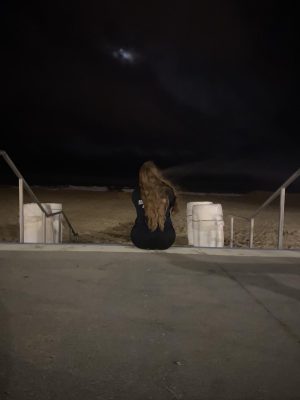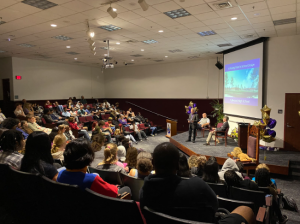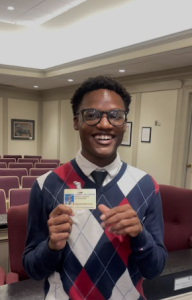How the Virginia Sex-Ed curriculum hurts students
February 12, 2018
Sex. It is a wide-ranging, natural, and important part of a human life, but somehow remains remarkably taboo and closed-off in schools across the nation. Sex-ed at Tallwood is representative of Virginia’s state guidelines on the subject, in that it teaches an abstinence-centric curriculum.
What students colloquially call “sex-ed” is actually called “Family Life Education.” Most students take a five-day Family Life course in ninth and tenth grade through their health and physical education course. Tallwood, like all Virginia public schools, must abide by Virginia’s standards of learning, which are made up by a select number of people in Virginia’s Department of Education for all public schools in the state to use. Students generally take their Family Life course in grades 2, 5, 6, 7, 9 and 10. Virginia’s standards of learning for Family Life Education include “age-appropriate instruction in family living and community relationships, abstinence education” and “the value of postponing sexual activity” (Virginia Department of Education).
Like Virginia, many states have an abstinence-focused curriculum. However, with the constantly evolving culture of the U.S, many school systems are beginning to relook at what they are teaching their students. Virginia Beach City Public Schools has revamped the Family Life curriculum for this year, though it is still an abstinence education that contains much of the same information as before, with some exploration of new topics such as human trafficking and the influence of social media that is meant to be more relevant to the student body.
Despite the helpful and comprehensive approach Virginia’s curriculum attempts to take, students have found that there are still many gaps in their classroom learning. When asked, students eagerly piped up with a number of suggestions about what they thought should be added to their sex education, as well as complaints they had about the existing one. One of the most popular suggestions was in regards to adding information about various contraceptives, and not sticking to a strict no-sex curriculum.
“I wish we were able to inform students about various contraceptives in a more informative manner. That is not allowed in our curriculum,” admits Tallwood health teacher Ms. Morris-Platte.
Of course abstaining from sex is the only surefire way to prevent pregnancy and STDs, but all the curriculum seems to be trying to do is scare students out of having sex. Meanwhile, students aren’t getting what they really need. The vast majority of students voted to get rid of the abstinence curriculum and begged for a comprehensive sexual education program that didn’t aim to scare students out of sex, and gave helpful and accurate information about contraceptives.
“I don’t understand why they think [an abstinence education] is effective at all,” says senior Christina Raynor. “It’s just in denial. People are going to have sex under the age of 18 no matter what, and they can’t pretend like it doesn’t exist. It’s ridiculous that they deny it, because they’re not reducing STDs or pregnancies.”
To be clear, asking for a comprehensive sexual education program doesn’t mean that all high school students are running around having sex. In a survey conducted by The Roaring Gazette of Tallwood students, only about 31% of surveyed students said that they were currently sexually active. However, over 60% said that they do not choose to practice abstinence, and those few who do largely attributed it to religious and personal values. This means that students need to be well-informed about contraceptives regardless of their personal situation. If students are currently or will soon be sexually active, they need to learn about contraceptives right away from a reliable source. If students are waiting until they meet the right person or get married before engaging in sexual activity, they need to be just as informed about contraceptives from a reliable source, because the likelihood is that they will not be looking to have kids right away when they do start having sex. All of this information is vital to learn as early as possible.
The current curriculum is sorely lacking. What students are currently being taught is mostly comprised of information that they already know, and this results in a room full of bored students. 83% of surveyed Tallwood students said they already knew everything or almost everything in their Family Life Education course, and 71% said they did not find the course helpful. Some students agree that the sex education program is largely ineffective, but shrug it off saying that they don’t need it anyway; they’ve learned all they need to know from their friends, the media, or the internet.
“Basically everyone who goes into sex ed already knows what it is,” says a sophomore Tallwood student who wished to remain anonymous.
There is no lack of information out on the internet for students to learn anything and everything about sex. Many students claimed that because this information is so readily available to them, they are often simply bored and embarrassed by the force-fed information in their Family Life classes. However, the problem with the plethora of information on the internet is that it can feed students false information or give them wrong ideas, impressions, and expectations of sex.
“Often our students think that the internet and peer resources are providing them with all the information, but after these lessons they find out that they were missing some important factual information,” claims Morris-Platte. “Real life is rarely accurately portrayed on TV or the internet.”
This is why students need something more from a sexual education course. There is no pretending that students aren’t getting an entire sexual education course from their phones and laptops and Netflix accounts. Regardless of what sort of decisions students make on their sexual behavior, a school sexual education program should be in place to ensure that students are doing whatever they choose to do safely.
There is another issue that is quite prevalent in the school’s Family Life program. Many students commented on the feeling of awkwardness and anxiety over what seems to be treated as a taboo subject. They have complained that they never felt comfortable enough to ask the questions they needed or wanted answered.
“I think they should be more real about what they are teaching,” comments another Tallwood student. “I think they are very safe of what they are teaching; they should be more direct to their students.”
Even health teachers have hinted at this notion.
“My opinion is that I would much rather direct instruction to the students’ needs every year. In other words, go on questions that students have each year. But that leaves too much gray area for teacher influence in the instruction. The parent is the ultimate sexual educator, so by creating a set of strict guidelines it takes the individual teacher’s opinions out of lessons. I appreciate the fact that the lessons on this contentious material is very strictly guarded to protect me as the teacher. I would love to be able to answer some of the students’ questions in class, though,” responds Morris-Platte.
This issue reaches beyond the generic man-and-woman sexuality as well. A vast number of students complained about the heterosexuality of the curriculum and how no information of broader sexualities was given. Especially at this crucial time in a person’s sexual development, it is critical to provide students with a knowledge and understanding of their own sexuality and what it all means for them. The fact that there are people who are born in a way that is biologically different from what society has normalized can no longer be ignored, and students agree that it needs to be embedded into their sexual education curriculum.
The general consensus among students was that they want more from a sexual education program. They don’t want boxes ticked off claiming that the students learned the state’s required material, they want an open and comfortable environment where they don’t have to giggle their way through the awkwardness, but can ask serious questions and be thoroughly informed about what they need to know about sex and how to be safe.
What students are really looking for is a comprehensive sexual education program. A comprehensive sexual education program would include information on abstinence as well as contraceptives in preventing pregnancy and sexually transmitted diseases and infections. It also teaches that sexuality is a natural, normal, healthy part of life, as opposed to a message designed to implant fear about the social, psychological, and physical consequences of teenage sexual activity.
“It’d be nice if we could maybe research sexual diseases…and about pregnancy.”
Students need to learn about the different types of sexually transmitted diseases and what symptoms to look for; not as a scare tactic, but to be aware in case the unfortunate should happen. Furthermore, they should know what to do in case of a pregnancy: how to tell the people who need to know, where to go, what to do, and what their options are. Virginia’s curriculum teaches “the benefits of adoption as a positive choice in the event of an unwanted pregnancy” (Virginia Department of Education), but does not go into further detail. Denying that students are engaging in sexual activity will not benefit anyone, and will certainly not help the students who truly need help and don’t know what to do just because nobody was honest enough to tell them.
Teaching students about contraceptives and how to know if they have an STD does not mean that they will think they can or should be going out and having sex now; it means that they can be well prepared when the time does come around. This ought to be the purpose of a sexual education curriculum: to educate and prepare students, not to push an agenda. Students will have sex when they make the decision to, and telling them they are doing something wrong and their life will be ruined if they do so is not going to stop them or do any good. Tallwood students have been very real about what they want from their school; now the question is: how real will the school choose to be with them?
Click here to access other articles in Volume 3, Issue 5 of The Roaring Gazette.












Barack Obama • Feb 25, 2019 at 2:42 pm
you’re welcome
Joshua Hansel • Apr 19, 2018 at 9:57 pm
thanks obama